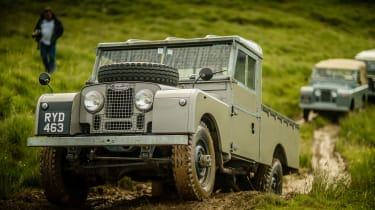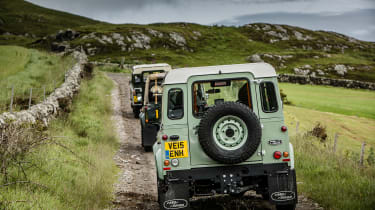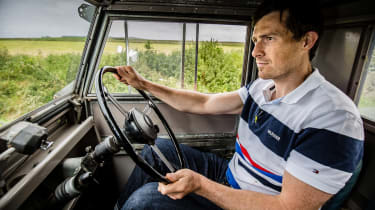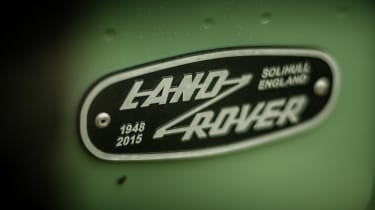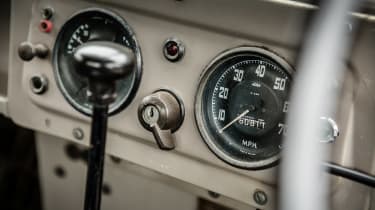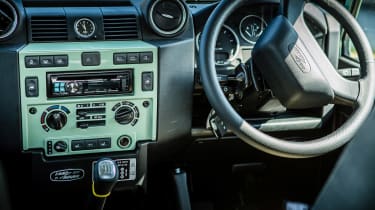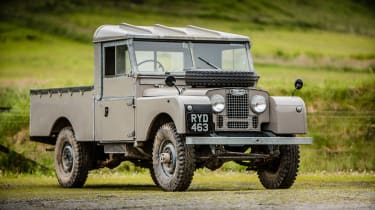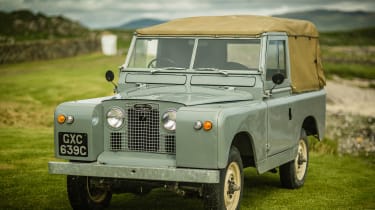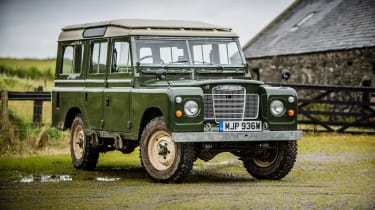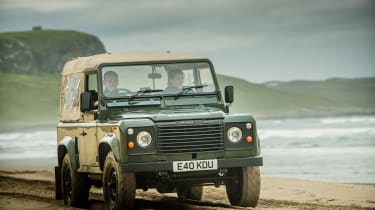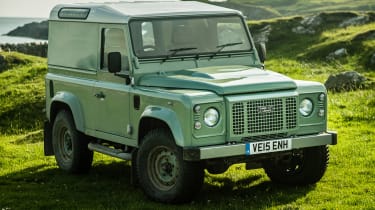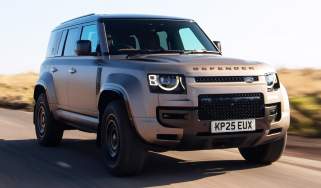Land Rover Defender: still the best at 60?
To mark the end of the Land Rover Defender, we drove a fleet of all the models on the island where it was conceived
Icon. It’s an overused term in the automotive lexicon. Really, there are only a handful of vehicles that warrant such praise – and the Land Rover Defender and its ancestors are among the worthy few.
This all-purpose 4x4 originally designed for post-war farmers has gone on to become a symbol of British ingenuity, engineering and craftsmanship – and even the British psyche. It sums up all that’s great about our small yet rather significant island, and in some ways, the vehicle’s shortcomings, and the problems that blighted its production, also echo what’s not so great about Britain.
• Land Rover Defender tour: witness the last days of an icon
But love it or hate it, you can’t deny that the silhouette of a Defender is as recognisable across the world as those other most notable motoring icons, the VW Beetle and original Mini. Arguably, however, it surpasses even these because, now in its 67th year, the Series Land Rover and Defender have been in continuous production longer than any other road vehicle. Sadly, though, all things must come to an end.
Eventually, Land Rover will replace the Defender with a new-from-the-ground-up model featuring a fresh design and different parts. As a final swansong, a range of limited-edition models has been built. We took one – the Heritage – to Islay, to drive it back-to-back with its ancestors and see just how much has changed (or indeed, hasn’t) since the first Land Rover rolled off the Solihull line back in 1948.
But why Islay? Well, the Western Hebridean island offers easy access to a variety of terrain that’s perfect for testing the Defender and its ancestors. Also, Islay holds a special significance for the brand; it was the place where the name Land Rover was first coined, as Spencer Wilks – the then-boss of the Rover Company – had an estate there.
However, the concept of building a Brit version of Willys’ Jeep was the idea of his brother Maurice, Rover’s engineering boss. And in 1947, the firm gave the green light to this all-purpose vehicle, hoping the car would help keep the brand afloat in the lean post-WWII years and provide employment for the huge workforce it’d amassed as part of the war effort.
Now, you’d expect a car maker to be pretty precious about its most historic models. Yet we were allowed to drive the vehicles down steep, narrow and tricky off-road tracks, where the older but smaller and lighter Series models seemed to cope better. It did feel bit strange being let loose in a valuable 1954 Series I 107 Pick Up on the tracks of Islay, though. Powered by a 53bhp petrol 2.0-litre, progress was sedate.
However, the engine was tuned for low-down torque rather than outright pace, which is far more important when off-roading. This enabled the Series I to keep chugging along in virtually any gear.
Good job, as there’s no synchromesh on first and second, so changing down required double declutching – in our case, often punctuated by a loud grinding noise. There’s no steering assistance, either, so having strong arms helps. A solid spine is key, too, as the Series I bounces like a jack-in-the-box on its rudimentary leaf-spring suspension.
While the very first version had permanent all-wheel drive, later in the model’s life this changed to a selectable system, engaged by pressing what’s best described as a plunger. Despite requiring far more concentration and determination to pilot than a modern vehicle, there was a certain charm to the way our old Series I drove.
The car used a steel box chassis with an aluminium body – as the Defender still does today. And the commonality continues, as a few parts, such as the bonnet cleat, are the same as are fitted to the modern version. Also, the distance between the centre of the main chassis legs that run the car’s length hasn’t changed in 67 years.
The interior’s been altered, though. Inside, the Series I is as spartan as a prison cell, with only the essentials: steering wheel, brakes, gearlever, seats and a few gauges. There’s no plastic trim – instead, you’re surrounded by exposed metal that, in this cosy cab, is all too easy to bruise an elbow on. There were no more creature comforts in the 1965 Series II 88-inch 2.25-litre petrol model we drove, either – which incidentally was used by Spencer Wilks on his Islay estate. However, at the time the Rover Company did offer such optional luxuries as door cards.
Despite the slightly larger-capacity 68bhp engine, our Series II felt virtually identical to its predecessor to drive… well, apart from a tendency to meander randomly across the road. Later, Roger Crathorne – known as Mr Land Rover on account of his decades of service to the brand – fixed the issue by tightening a few loose steering box bolts, a job that took only a few minutes. We’re not sure a steering issue on a Discovery Sport could be so easily remedied.
While the Series II’s mechanical changes were minimal, there were some significant visual ones. Unlike the original Land Rover, this car was specifically ‘styled’, by a team led by the man behind the look of the Rover SD1. In fact, the distinctive shoulder line introduced on the Series II is a key feature that’s remained on the Defender to this day.
What didn’t stick was the headlamp location. For the new Series III in 1971, these were moved to the wings to meet Belgian legislation. Inside saw some major changes, too. A ‘soft-touch’ dash was fitted, mainly to cover up a crash bar – an addition required for this model to be sold in Germany. Also, the instruments were moved from their central position to behind the steering wheel, while an optional fresh-air ventilation system was offered for the first time.
The four-speed box now had full synchromesh, so there were no grinding noises when we drove a 78bhp 2.25-litre petrol 109-inch Station Wagon from 1980. From 1979 the Series III was also available with the Range Rover’s V8. This required an extended engine bay, which saw the grille move flush with the wings – a design feature that was incorporated into all 90, 110 and 130 Land Rovers introduced in 1983.
We got to drive a very special ‘Ninety’: one of only two 40th Anniversary Land Rovers built at the end of 1987. Initially, 40 ‘celebration’ models had been planned, with each set to have the number 40 in their registration. But the run was cut short as strikes at the factory halted production. That’s the official line anyway…
Insiders claim Rover’s then-boss didn’t care much for heritage, and was never keen on these 40th anniversary models in the first place. It seems like a huge oversight now, but back in the darker days of the British auto industry, the Land Rover was starting to seem a little outdated compared to Toyota’s more reliable, more comfortable yet just as capable 70 Series Land Cruiser.
To be fair, the 90, 110 and 130 models were all still a massive improvement over their predecessors. The most important change was the use of the Range Rover’s coil-over suspension. Climbing out of the Series III into the 90, the difference in on-road comfort and handling was vast. It was the same with the brakes, as the use of discs instead of drums meant the 90 actually stopped when we pressed the pedal.
Also, its 2.5-litre engine and five-speed gearbox felt much smoother than the powertrain in the Series III, and there was the benefit of permanent, rather than selectable, four-wheel drive plus a lockable centre differential.
While the name would change to Defender in 2000, due to the Discovery’s arrival, there were virtually no major updates until 2007. Then the car received a modernised cabin and a 2.4-litre diesel, which later changed to the 2.2-litre in the Heritage run-out version we drove.
Next to Land Rover’s latest car, the Discovery Sport, the Heritage felt rather antiquated, but it’s still light years ahead of the original Series I. And creature comforts such as the climate control and heated seats were certainly welcome when the temperamental Islay weather took a turn for the worse…
The £27,800 Heritage is one of three run-out specials, alongside a hardcore Adventure, fitted with extras such as a snorkel, and a luxury Autobiography, which at £61,845 is the most expensive Defender ever. The Heritage features the same light green paint as the first Land Rover to roll off the production line back in 1948. It even wears that vehicle’s HUE 116 licence as a badge on its wings.
In our eyes, this Heritage model is the most desirable of the limited-run trio. It pays homage to the beginning of an era, while at the same time signifying its end – a fitting link to a fresh chapter in the history of the brand and the imminent arrival of a replacement that’s all-new from the ground up. But whether this future Land Rover will earn the same iconic status as its forebears, only time will tell...
Land Rover Defender timeline
1948-1958 Series I
The first Land Rover off the Solihull line was dubbed Huey on account of its HUE 166 reg plate. Like every Series I that followed, it was a working vehicle built on a steel box-section chassis with aluminium bodywork, a 50hp 1.6-litre petrol engine, leaf-spring suspension, permanent all-wheel drive and little else for £450. A 2.25-litre diesel arrived in the last year of production.
1958-1971 Series II
Unlike its predecessor, the second-generation Land Rover was ‘styled’, and its shape has essentially been carried through to today’s Defender. There was a bit more room inside and greater load-carrying capacity, while such luxuries as door cards and mirrors were available. Also, the petrol engine was increased to 2.25 litres and 77bhp, and a six-cylinder was later offered.
1971-1985 Series III
While little was changed mechanically, the Land Rover’s appearance was heavily influenced by legislation. Belgian law saw the headlamps move from the grille to the wings, while German rules required a crash bar to be fitted across the bulkhead. This was covered up with a new soft-touch dash, which also mounted the dialsin front of the driver rather than centrally.
1983-1990 90, 110, 130
AT the end of its life, the Series III was offered with a V8 and the engine bay extended to accommodate it. The resulting flush grille was carried over into the design of the 90, 110 and 130 (named after their chassis lengths). They also had coil-over suspension from the Range Rover, disc brakes and five-speed manuals for the four-cylinder petrol and diesel, which went up to 2.5 litres.
1990-2015 Defender
Following the Discovery’s 1989 launch, the Land Rover was renamed the Defender. However, there weren’t any major updates until 2007, when new exterior trim and a fresh 2.4-litre diesel were added. The interior was also redesigned to boost comfort. Yet even today, beneath the skin some of the chassis dimensions remain exactly the same as those on Huey 67 years ago.
Do you or have you owned a Defender at some point? Let us know your experiences in the comments below!
Find a car with the experts
